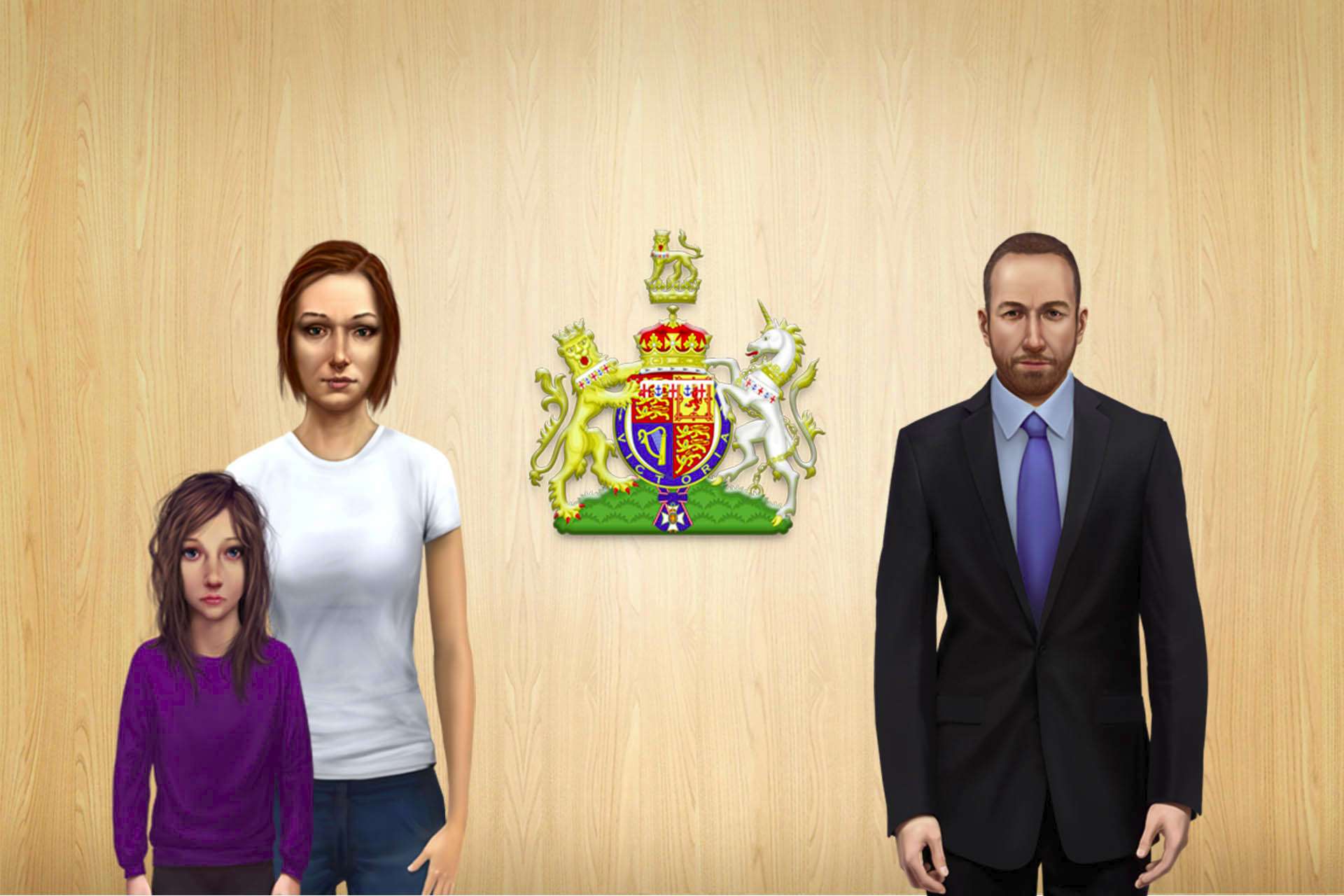‘myCourtroom’ Rosie’s family go to court is a simulation for young people and professionals on the family court arena and it follows Rosie’s family as they go to court, two years after the Rosie 2 simulation.
This serious game was devised in partnership between the University of Kent’s Centre for Child Protection and Cafcass. The training offers a safe medium from which to explore court skills and gives professionals an opportunity to experience and develop their courtroom knowledge. It is designed for professionals in the child protection arena who attend court. The objective was to take the key messages from the literature (set out below) and from a professional survey carried out by Cafcass, to create a bespoke training environment which mirrored the ‘real world’ and ‘real life’ situation of the court arena (Minocha and Reeves 2010). Using existing research and information gained from the survey, ensured that the basis upon which the simulation was built was robustly targeted to incorporate the learning outcomes.
Primary research, conducted as part of the background to developing this simulation, suggested that local authority social workers and Family Court Advisors in particular expressed anxiety about giving evidence in court; worried about being cross-examined and in citing research evidence, as well as preparing for court generally. These elements have all been integrated into the simulation.
Key messages from research
A review of recent literature suggests that there are several key themes in relation to practitioners in the court arena, including:
- A lack of confidence in learning and understanding the law – practical application makes information about the legal system, court rules, and legal concepts easier to understand and retain (Seymour 2006)
- A need to understand the importance of preparing yourself for court – knowing your case so that you are credible when presenting your rationale for decision making. (Seymour 2006)
- A need to understand fully the role and expertise of other professionals in the courtroom (e.g., court clerk, legal advisor, judge, solicitor, experts) (Brammer, Boylan and Dowding 2013; Burry et al. 2011)
- A need to improve the confidence and status of social workers in the family court. Some practitioners feel that their views are not given the same level of credibility as expert witnesses, due to a perceived lack of preparation or lack of respect for any specialised knowledge they may have. (Seymour 2006; Eccles and Erlen 2008; Lewis and Erlen 2012; Burry et al. 2011)
- A need to improve confidence to scrutinise details and challenge – professional confidence to give evidence of their own knowledge and opinions, even if this does not support the line of their own party, if, on professional grounds, they do not agree. (Seymour 2006; Holt and Kelly 2012)
- A lack of confidence in citing research when giving evidence – practitioners fear they will be undermined during cross-examination due to poor references (Eccles and Erlen 2008; Lewis and Erlen 2012; Burry et al. 2011)
- Anxiety about giving evidence in court – explaining and presenting issues to the judge (Brammer, Boylan and Dowding 2013; Burry et al. 2011; Eccles and Erlen 2008)
- Anxiety about cross-examination and preparation for this (Seymour 2006; Brammer, Boylan and Dowding 2013)
- Difficulty in providing court information for social workers appearing in a number of courts with differing expectations and procedures (Seymour 2006; Brammer, Boylan and Dowding 2013)
- Practitioners can find working in courts stressful – this can result in defensive practice in which the values of their profession appear to become side-lined or obscured (Seymour 2006)
Other useful sources of information:
Brammer, A. Boylan, J. & Dowding, S. (2013). Curriculum guide for continuing professional development on pre-proceedings and court-related skills in cases concerning the care and protection of children. British Association of Social Workers (BASW). [Online]. Available from: https://www.basw.co.uk/resources/curriculum-guide-continuing-professional-development-cpd-pre-proceedings-and-court-related [Accessed 19 November 2020].
Burry, C.L., Shdaimah, C.S., Richardson, L. and Rice, K., 2011. Child welfare in the court: A collaboration between social work and law faculty to prepare social work students for work with the courts. Journal of Public Child Welfare, 5(4), pp.426-444.
Dickens, J., Masson, J., Garside, L., Young, J. and Bader, K., 2019. Courts, care proceedings and outcomes uncertainty: The challenges of achieving and assessing “good outcomes” for children after child protection proceedings. Child & Family Social Work, 24(4), pp.574-581.
Eccles, C and Erlen, N (2008) Evidence Matters: Social work expertise in the family court. A handbook, Research in Practice.
Greeno, E.J., Bright, C.L. and Rozeff, L., 2013. Lessons from the courtroom: Perspectives from child welfare attorneys and supervisors. Children and Youth Services Review, 35(9), pp.1618-1624.
Holt, K. and Kelly, N., 2012. Rhetoric and reality surrounding care proceedings: family justice under strain. Journal of Social Welfare and Family Law, 34(2), pp.155-166.
Holt, K., 2016. Contemporary family justice: Policy and practice in complex child protection decisions. Jessica Kingsley Publishers.
Lewis, J and Erlen, N. (2012) Evidence Matters in Family Justice, Legal Briefing, Research in Practice.
Minocha, S and Reeves, A (2010). Designing for usability and accessibility in 3D virtual worlds. Learning Technology, 12(2) pp. 4–6.
Seymour, C. (2006). A model to support the development of courtroom skills Journal of Practice Teaching & Learning 7(3) 2006-07, pp.70-81. DOI: 10.1921/19644
Seymour, C. and Seymour, R., 2007. Courtroom skills for social workers. Learning Matters.
Seymour, C. and Seymour, R., 2011. Courtroom and report writing skills for social workers. Learning Matters.
Reeves, J., Green, T., Marsden, L. and Shaw, N., 2018. myCourtroom: Rosie’s family go to court; the use of simulations in preparing social workers for court. Social Work Education, 37(2), pp.234-249.
